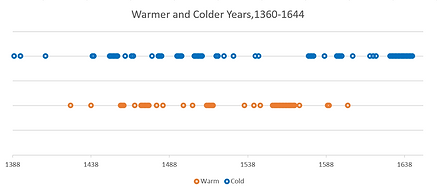
Disastrous Weather Analysis
Disastrous Weather Analysis
Disastrous Weather Analysis
THE EXTREME WEATHER IN THE WAR
IN EAST ASIA
Collapse of Ming Dynasty(1644)
<Political background>
On Yongle Emperor, excessive foreign aid, navigation and tribulation trade have become a major source of trouble for ruining the country, and later emperors suffer severe financial difficulties. And at that time, the number of royal families receiving government subsidies reached 23,000 and the Ming Dynasty government provided them subsidies even if state coffers were depleted. In addition, Ming Dynasty has weakened its national power due to the northern barbarians and southern Japanese, participation in the Japanese invasion of Korea in 1592, and internal rebellion. Furthermore, the expansion of the rank ‘shenshi(紳士)’ who have who have qualified ‘shengyuan’(生員). and the ‘shenshi layer(紳士層)’ have become village heads or local government officials to easily win bribes. In the end, the lives of the people became more painful.

Ming Dynasty, where commerce flourished and consumption took place briskly.
Source : 글항아리
<Climate background>
1) Cold
From 1569 until 1644, there are only three years of warmer than normal temperatures. With the rapid cooling from the 1550s at the end of the Ming Dynasty, it has experienced one of the coldest periods in the past 1,000 years. There are only one warmer year against twenty three year abnormally cold. In 1692, the temperature dropped further, leading to a cold spell until the end of the dynasty. The temperature in China from the 1560s to the 1650s was at least 0.5°C lower than in the 1951 to 2000s, and the cooling rate in the 1550 to 1650s was 0.4°C/100 years. This cold climate was reported 36 times in the North China Plain between 1571 and 1644, and was recorded over the all year in the 1620s.

According to Taiwanese climatologist Ryu So-min define 1600-1643 as a 5th the little Ice Age.
Source : Atlasnews

Warmer and Colder yrs, 1360 - 1644
source : DW - Team C

Cold, Earthquake, and Sulfate Spikes yrs, 1360 - 1650
source : DW - Team C
2) Drought
We supposed when global cooling occur, these El Niño mechanisms will work. Reduced solar energy received on Earth lowers global temperatures. Then the heat received by the equator decreases, and the global circulation of the Earth's atmosphere are weaken. As a result, the trade winds blow weakly, resulting increases the risk of more, and more severe, El Niño events.
The El Niño effect does not fully explain China's long dry weather. However, this graph can be shown that drought in China and El Niño have some correlation.
El Niño year the monsoon weakens and heavy rains fall. During this period, as the weakest East Asian monsoons occur, there are severe droughts occurred in Ming. The severe droughts occurring in 1627–1643 were a key trigger to the peasantry uprising.

Drought and El Niño Years in 1540 - 1644
Source : DW - Team C
These droughts also played a significant role in promoting the peasantry uprising, especially reviving the peasantry troops by recruitment of famine victims when they nearly perished in 1633 and 1638, and severely disrupting the food supply for the government troops, resulting in the final defeat of the government troops by the peasantry troops. During 1368–1644 ,the frequency of extreme droughts and concentrated floods in the North China Plains was 12.3 and 4.3%, but in 1581–1644 the rates were 21.7 and 4.7%, respectively. Also, the number of persistent extreme droughts occurred more frequently.
3) Famine
The most enduring and destructive famine period in the Ming Dynasty was the last of the kingdom. When the drought returned in 1637, it was in collusion with the cold weather, creating a debilitating disaster that ruled the last year of the dynasty.
The worst year was 1641, when famine reached the Zeng Wei area. The famine really ended in 1644. Famine occurred repeatedly during the last second century of the Ming Dynasty.
In the Ming Dynasty, three years of severe famine occurred in 1544-46, and the beginning was consistent with the El Niño year. The greatest famine of the 16th century came in the second decade of Wanli era. It began in the north in 1586 and spread to Zhili and Zhejiang the following year, overwhelming most of China in 1588.

Correlation of Drought, El Niño, Famine, Cold, and Dry Yrs in 1540 - 1644
Source : DW- Team C
<Results>

The driving forces and pathways of political, financial, and social factors leading to the collapse of the Ming dynasty
Source : How climate change impacted the collapse of the Ming Dynasty
1) Political
Fiscal deterioration and inflation have occurred as political corruption has prevented the government from doing its job. As the mandatory ratio of citizens has been unreasonably raised due to worsening finances, society has become unstable and demand for military power to control internal revolt has also increased. Due to the heightened military pressure, the financial deterioration resulted in deeper administrative problems and inefficient governance, and the kingdom was finally collapsed by the worsening of the internal class' misconduct.
2) Climatic
climate deterioration → decline in agricultural production → fiscal deterioration vs unreasonable upgrade in the duty ratio → increase in social vulnerability.
climate deterioration → decline of agricultural production → decrease of grain ration → food crisis, price inflation and famine → popular unrest. Both of these pathways led to the peasant uprising and increased military pressure.
Finally, the impatient people began to rise up in revolt, and the Ming Dynasty was destroyed by continued pressure from inside and outside.